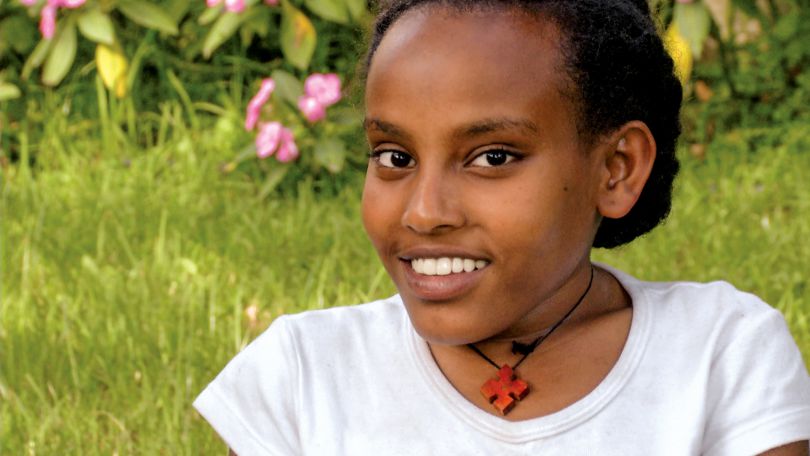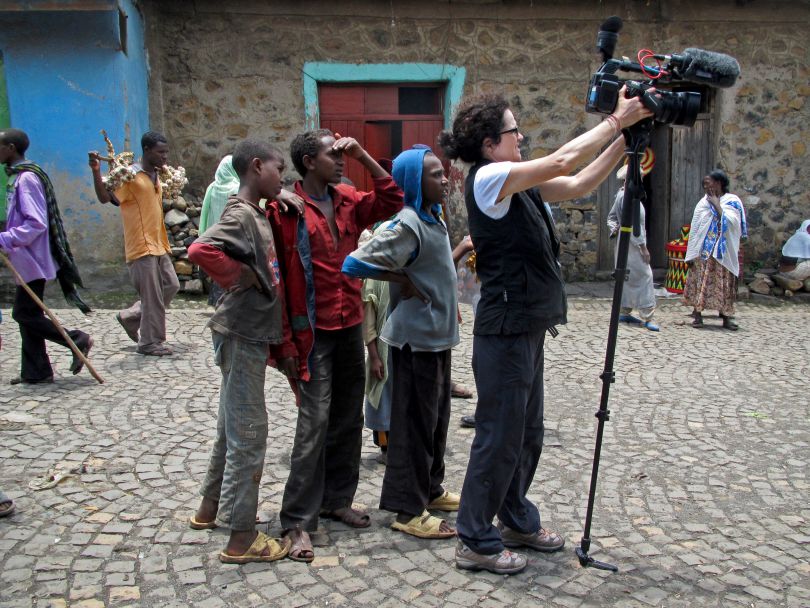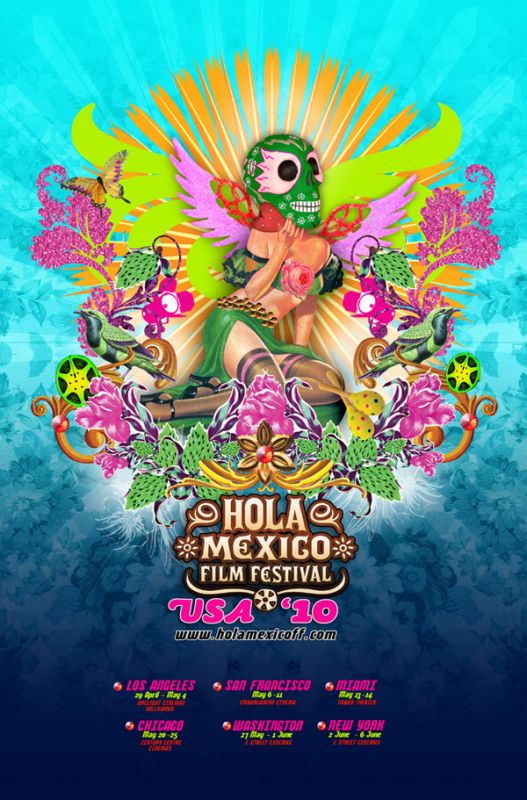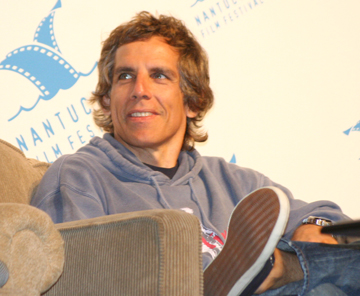
By its title alone, Zemene, Melissa Donovan's captivating documentary says there's something special about its name character. There is. Right away when we meet this Ethiopian 10 year old, her spark and lucidity pull us in.
Zemenwork (Zemene) Tiget has an acute spinal curvature called kyphosis. Accompanied by her Uncle Menormelkam, she has come to city of Gondar seeking medical treatment that can keep her from death's door. No such luck -- yet.
We discover Zemene at the same the filmmaker does, as the young orphan is approaching a café. She has just been turned away by the doctor and is soon headed back to her village, stripped of hope. This is the moment when chance -- and Donovan's camera -- intervenes. Spinal expert Rick Hodes happens to be quenching his thirst within eyeshot, and he too is magnetized by young Zemene. After examining her at his hotel, he offers to help her if she can make it to his clinic in the remote capital city of Addis Ababa. On the spot Donovan decides to follow Zemene home and make a documentary about her.
"What drew me to this film was my attraction to Zemene," Donovan told me in Manhattan, well before the film would head for Hawaii to screen at the Pacific Rim International Conference on Disability and Diversity.* "It was the combination of someone who was so fragile, with the bent back, yet had this spirit and this smile; she lit up. As a woman seeing this little girl who was so vulnerable but at the same time so beautiful, I felt compelled to capture as much with her as I could."
The encounter marked Zemene's first exposure to a white woman, let alone to a camera. "She was so shy, but she immediately held my hand," recalled Donovan. The Boston-raised filmmaker herself was primed for some handholding; Zemene would be her first go at directing. She had come to Ethiopia as a cinematographer for hire on a documentary about the Ethiopian millennium, for which Dr. Hodes was a potential character. She was merely getting B-roll when Zemene literally entered the picture.

This fateful crossing of paths also brought the Ethiopian health care system into Donovan's viewfinder. It comes as no surprise that funding is the key snag for patients in a farming village like Zemene's. She was so malnourished when Dr. Hodes first took her on that he needed two years to get her healthy -- and schooled -- enough to undergo spinal reconstruction. The operation was performed in Ghana by the world-class specialist Dr. Oheneba Boachie-Adjei.
Donovan makes much of both the doctors' generosity and of Zemene's own efforts to give back to the community by advocating education. And that's exactly what the director means to get across: caring is contagious. In a country like Ethiopia, where the ratio of patients to doctors is 33,000 to one, this may seem a flimsy system to pin hope on, but Zemene's case argues cogently in its favor.
As we watch Zemene prep for her big speech at Dr. Boachie's annual fundraiser in New York to help others in her situation, we are aware of the larger message, which is that education and world communication make the difference between a healthy existence and a life that is short, nasty and brutish. Donovan fleshes out that message and her filmmaking process below:
Q: What pursuaded you to follow Zemene and Menor to their village?
MD: I wanted to make sure that Zemene's family knew that Dr. Rick was real. Here was this white guy who said he was a doctor, but he didn't look like a doctor.
Q: They're right: he's more of a genie. How did he come to work in Ethiopia?
MD: Rick has been doing this in Ethiopia for more than 20 years. He doesn't have boundaries of where work stops and leisure starts. He grew up in Long Island and studied Geography in Alaska. He went to medical school, got a Fulbright and ended up working in Calcutta with Mother Teresa. He did some work in Rwanda and then the JDC (The American Jewish Joint Distribution Committee) brought him to Ethiopia to be the medical director. It was a time of a lot of turmoil with the Mengistu government and a lot of famine was happening. Israel wanted to protect (its citizens) and help make sure that they were healthy. Dr. Hodes's primary responsibility was running these two clinics, one in Gondar and one in Addis, for the Ethiopian Jewish population.
Q: How did spinal disorders come to be such a big part of his work?
MD: During that time he kept bumping into kids with bad backs and heart conditions, especially in the rural areas. A lot of the kyphosis that he deals with comes from tuberculosis. Because of Rick's faith and his desire to help those who have no other way of being helped, he felt compelled to do whatever he could. That led to him reaching out to health professionals from all over the world. And that led to meeting Boachie and to sending some kids to be operated on by him. Slowly that turned into the work he does now.
Q: What can you tell us about Dr. Boachie's work?
MD: Dr. Boachie was an orthopedic surgeon at the Hospital for Specialty Surgery. He built the clinic in Ghana, which is why he has the fundraiser. He goes there every three or four months and he gets volunteers from all over the world to come and work with him. They operate on as many kids as possible when he's there. He gets kids from all over Africa and he does surgeries for a fraction of the cost.
Q: Let's go back to that first trek home with Zemene and Menor. What insights did you take away from the village?
MD: It was really there that I saw what's it's like living in a rural area and having no information of the outside world and then seeing how people respond when they first learn that there is something that can be done to treat someone. At first the grandfather didn't understand. He was like, "If in Gondar the hospital said they can't help her, then there's nothing anyone can do. Why are we letting her go to Addis Ababa?" The grandmother was really modern and bold. She said, "Let her go. We have to try."
Q: From an early age, Zemene experienced terrible bullying for being different, yet when she came back to the village after being away for five years, she didn't act at all resentful. Were you surprised to see such nobility of spirit in an adolescent?
MD: That's why I opened the film with her wisdom, "We don't live a thousand years." Where does that come from?! Zemene's attitude about her former tormenters was, "They're my family. I love them." When I went back to the village, I was like a protective mother, because I'd heard stories. Zemene had to hold me back. Her mother died when she was a baby and her father abandoned her and left her to the grandparents to raise. She taught me so much about patience and forgiveness. She just had this open heart.
Q: Why does Zemene's process of developing her fundraising speech serve as a throughline?
MD: The speech is like her diary. At the beginning you hear her voiceover. I bookend it at the end with her actual speech. I started the film in 2007 and we brought Zemene here after about five years. She raised all that money with her speech. Wasn't she good on stage?
Q: She was beyond good. I was blubbering.
MD: So I'm there filming in front. I have my camera on my monopod. Tears are streaming down and I'm trying to hold the camera steady. And all I'm thinking is, She thinks she's Beyonce! We had gotten her hair done. She had that sparkle in her eye.
Q: She evolves into this beautiful, powerful young woman before our eyes.
MD: I think it's a matter of her allowing hope to exist and having the courage to hang on. It was always there, but her confidence was allowed to blossom because Dr. Rick gave her the opportunity to get medical care.
Q: How has Zemene's life changed?
MD: Rick likes to ask kids, "What's the worst thing that ever happened to you?" If they say, "my back," he'll say, "That's the best thing that happened to you!" I think that's true in Zemene's case. If she hadn't had her back issue, she would have been married at the age of 12 or 13. She would be farming and following in the footsteps of generation after generation of women having to live these hard lives that are in jeopary of early death, with no education and no means for self-development.

Q: Although your film looks at tough issues, we leave feeling as if we've just taken a beautiful journey. What were the driving aesthetic lights for you?
MD: First of all, it's not very hard to shoot over there because it's so beautiful. I went in September-October, after the monsoons. Everything's really lush and the yellow flowers are in bloom. It's almost like Terrence Malick shooting at twilight for Days of Heaven. Second, the people are so beautiful. Third, the love between family is so amazing that it's just pure joy to film. One of the things that I realized is how often you get stale when you're shooting in your own language. You're understanding the dialogue and you've heard it before or you've approached an interview like this before and you end up with the same frame. You're not looking at it visually. Over there, since I didn't know a lot about what they were saying and the translation came at a delay, I had to go on the gut. I was going on emotion. I didn't think: Oh, I need overage; I need a wideshot. I thought more about what made me feel and where I wanted to look. Aesthetically and emotionally I'm guided by the light.
Q: Given the amount of shots where Zemene is looking directly at the camera, it appears that she, herself, provides light.
MD: That was a way for Zemene and me to connect, with me representing the audience. She's telling us her diary in the first person. So now and then I had her break that fourth wall and connect with us by looking right through the lens. This is her story.
* For disclosure, I am a keynoter at PacRim, and programmer of its mini-film fest.
































